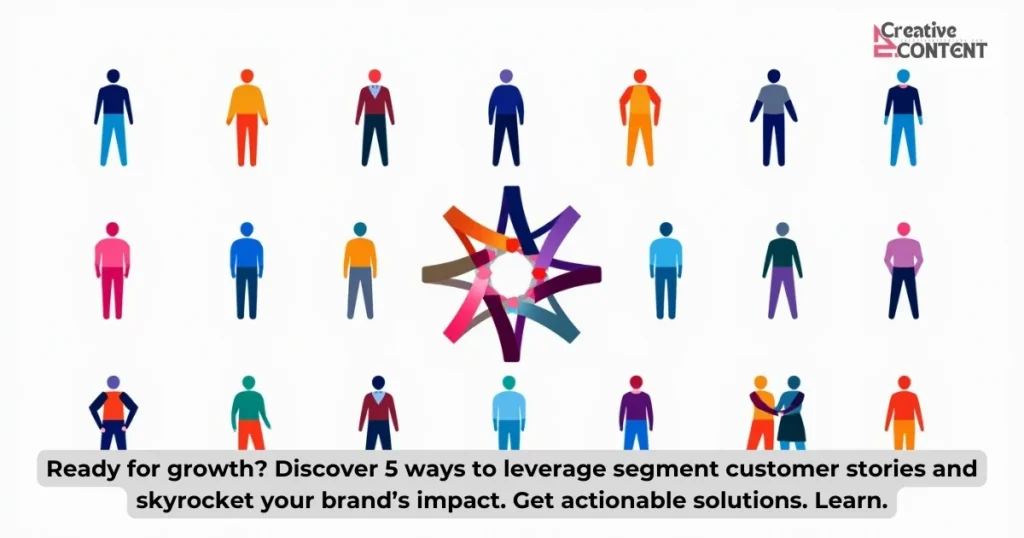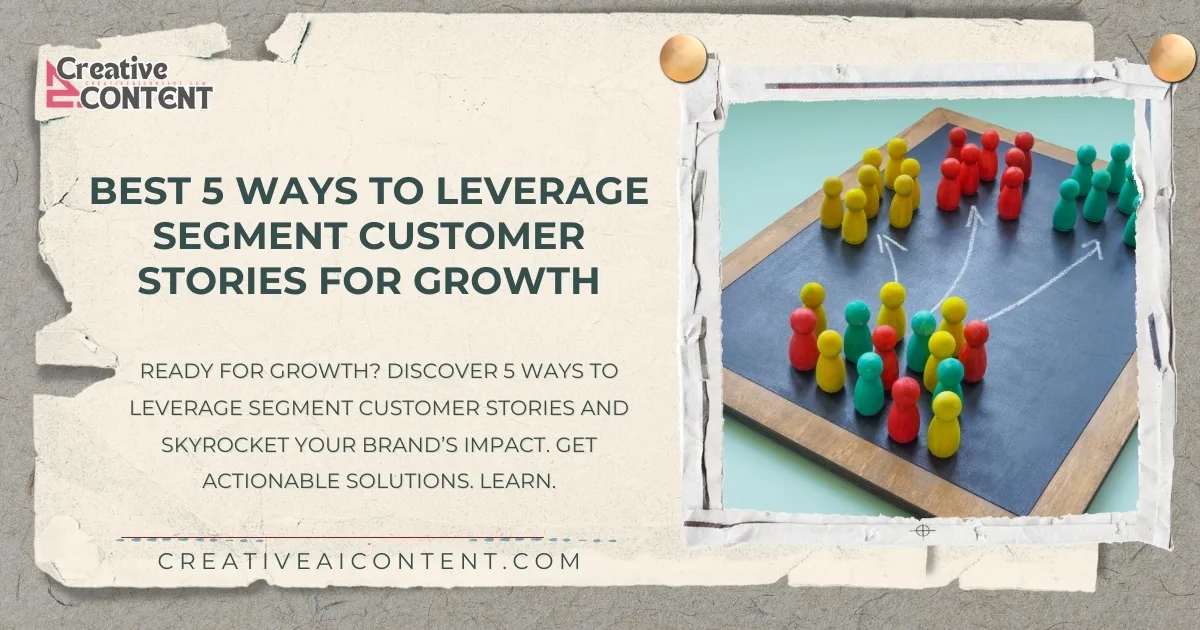In today’s competitive business world, customer stories are more than just testimonials—they’re powerful tools that can drive growth. But here’s the secret: not all customer stories are created equal. When you segment customer stories, you unlock unique opportunities to connect with your audience on a deeper level. By tailoring these stories to specific groups, you can create relatable, impactful content that resonates with different segments of your audience. Whether you’re in marketing, sales, or customer experience, leveraging segment customer stories can transform how you engage with your customers and grow your business.
So, what exactly are segment customer stories, and why do they matter so much? Let’s dive in and explore how you can use them to fuel your business growth.
Table of Contents
- Best Way 1: Identify and Collect Authentic Customer Stories
- Best Way 2: Analyze and Segment Customer Stories for Targeted Messaging
- Best Way 3: Leverage Customer Stories Across Multiple Marketing Channels
- Best Way 4: Integrate Customer Stories into Your Brand Narrative
- Best Way 5: Measure and Optimize the Impact of Your Customer Stories
- Conclusion
- FAQs
- Sources
What Are Segment Customer Stories?
Segment customer stories are narratives about your customers’ experiences, grouped based on shared characteristics like demographics, behaviors, or preferences. Instead of treating all customers the same, segmentation allows you to tailor stories to specific audiences. For example, a fitness brand might share success stories from busy professionals in one campaign and college students in another.
Why does this matter? Because different segments have different needs, challenges, and goals. By segmenting your customer stories, you ensure that each group feels seen and understood. Industries like e-commerce, healthcare, and SaaS benefit greatly from this approach. For instance, an e-commerce brand might highlight stories from first-time buyers versus loyal customers to address their unique journeys.
Segmentation is key to making your stories relevant and actionable. And when done right, it can set the stage for meaningful connections that drive results.
Best Way 1: Identify and Collect Authentic Customer Stories
Gathering true and real customer experiences is the first step. When you collect genuine stories, you build trust with your audience. This trust is key to business growth. Using segment customer stories means you do not treat every story the same. Instead, you pick the ones that best show your customers’ true feelings.
Why Genuine Customer Stories Matter
- Trust and Credibility: Real stories show that your brand truly cares about its customers. When a customer tells their experience, it is like a friend sharing advice.
- Social Proof: When many customers share their stories, new buyers feel more confident in their choices.
- Guided Improvements: Knowing what works and what does not helps you improve your product or service.
Methods to Collect Customer Stories
There are many ways to gather these stories. Here are some simple methods:
- Surveys: Ask your customers to fill out a short survey about their experience. Keep questions clear and easy.
- Testimonials: Request written or video testimonials. Ask for details like what they liked most.
- Interviews: Talk directly to customers in a friendly chat. Record their stories so you can share them later.
- Social Media Listening: Monitor your social media channels for posts about your brand.
When collecting these stories, always keep the focus on segment customer stories. This means you should record details that can later help you group these stories by common themes, such as why a customer loves your product or how they use it in their daily life.
Best Way 2: Analyze and Segment Customer Stories for Targeted Messaging
Once you have a pile of stories, it is time to sort them. This is where data comes in. By analyzing and grouping these stories, you can send the right message to the right group. Using segment customer stories helps you make your message personal.
The Role of Data-Driven Analysis
Data-driven analysis means you look at the facts from your stories. Ask questions like:
- What are the common themes?
- Which stories show a similar benefit?
- How do different customer groups talk about your brand?
When you answer these questions, you can see patterns. This helps you decide which stories fit which group.
Techniques for Segmenting Stories
Here are a few ways to segment customer stories:
- Demographic Segmentation: Group stories by age, gender, or location. For example, one group might be young customers who talk about style, while another group might be older customers who mention reliability.
- Behavioral Segmentation: Look at how customers use your product. One group might focus on the ease of use, and another on the quality.
- Feedback Segmentation: Use survey ratings or comments to group stories. You might have one group that is very happy and one group that suggests improvements.
By using segment customer stories in your analysis, you make your messaging more personal. This means your emails, posts, and ads can speak directly to each group’s needs. It helps your audience feel seen and understood.
Benefits of Segmented Messaging
- Personalization: Each group gets a message that feels custom-made.
- Relevance: Your messages will match what each group cares about.
- Increased Engagement: When customers see their own words and experiences reflected, they are more likely to act.
Best Way 3: Leverage Customer Stories Across Multiple Marketing Channels
Your collection of segment customer stories is a treasure trove that can be shared in many ways. Using these stories on different platforms will help you reach a wider audience and keep your message consistent.
Integrating Stories into Social Media
Social media is a great way to share customer stories. Here are some ideas:
- Posts and Updates: Share short quotes or testimonials with a friendly picture.
- Stories and Reels: Create quick video clips that show real customer experiences.
- Live Sessions: Host live chats where customers can share their stories in real time.
Using Customer Stories in Email Campaigns
Emails are another powerful tool. Consider these tips:
- Feature a Story of the Week: Send an email that highlights one customer story.
- Personalize Emails: Use segments to send tailored stories to different groups.
- Include Visuals: Use images and short video clips to make the stories more engaging.
Incorporating Stories into Blog Posts
Your blog is the perfect place for deeper storytelling. You can:
- Write Detailed Case Studies: Show how a customer overcame a problem with your product.
- Create How-To Guides: Use customer stories as examples in guides.
- Share Tips: Explain how different groups of customers use your product.
When you spread segment customer stories across channels, you maintain a consistent and strong narrative. This cross-channel strategy makes your brand feel united and trustworthy.
Benefits of a Consistent Narrative
- Brand Cohesion: Your story feels the same whether seen on social media, email, or your blog.
- Increased Reach: More channels mean more chances to connect with different audience groups.
- Engagement: A unified story helps build a strong emotional connection with your audience.

Best Way 4: Integrate Customer Stories into Your Brand Narrative
Your brand’s story is more than just what you say about your product. It is built on the real-life experiences of your customers. Using segment customer stories in your brand narrative makes your story authentic and relatable.
Reinforcing Brand Identity and Credibility
Customer stories add a personal touch to your brand. They show that real people benefit from what you offer. This helps build a strong brand identity. Some benefits include:
- Increased Trust: When customers see real feedback, they trust your brand more.
- Authenticity: Genuine stories make your brand feel real and relatable.
- Differentiation: Stories help set your brand apart from competitors.
Ways to Incorporate Customer Stories
Here are some simple ways to weave these stories into your brand narrative:
- About Us Page: Add a section that features real customer stories.
- Product Pages: Use quotes and mini case studies on product pages to show benefits.
- Marketing Materials: Include stories in brochures, ads, and presentations.
Examples of Brands Using Customer Storytelling
Some brands do a great job at using customer stories. For example:
- Brand A: Uses video testimonials on its website to show customer success.
- Brand B: Has a dedicated blog section for customer stories that tie into its mission.
- Brand C: Features customer quotes on social media, reinforcing its brand promise.
Using segment customer stories in your brand narrative shows your audience that your brand is more than just products. It is a community of real people with real experiences. This builds long-term loyalty and positions your brand as a trusted leader in the market.
Best Way 5: Measure and Optimize the Impact of Your Customer Stories
After you share your segment customer stories, it is important to see what works and what does not. Measurement is key. By tracking the impact of your stories, you can make changes that improve your results.
Key Performance Indicators (KPIs) for Story-Driven Campaigns
Here are some KPIs to consider:
- Engagement Rate: Track likes, comments, and shares on social media posts.
- Click-Through Rate (CTR): Measure how many readers click on links in your emails and blog posts.
- Conversion Rate: Look at how many visitors take action after reading a customer story.
- Time on Page: Check if readers stay on your page to read the full story.
- Customer Feedback: Collect direct feedback on the stories through surveys.
Tools and Strategies for Tracking Performance
There are many tools to help you track these KPIs. Consider using:
- Google Analytics: See how your blog posts and website pages perform.
- Social Media Insights: Use built-in analytics from platforms like Facebook and Instagram.
- Email Marketing Software: Track open and click rates in your campaigns.
- Survey Tools: Ask customers directly for their thoughts on your stories.
Tips for Refining and Optimizing Story Content
Once you have data, use it to improve your strategy. Here are some tips:
- A/B Testing: Try different versions of a story to see which one gets more engagement.
- Refine Messaging: Adjust the language or visuals if data shows lower engagement.
- Update Regularly: Refresh old stories with new data or customer updates.
- Segment Your Audience: Use your data to further refine how you segment customer stories for better personalization.
By measuring the success of your segment customer stories, you can see what works best for your audience. This ongoing process of testing, learning, and refining will help you get the most value from every story you share.
Conclusion
To recap, using segment customer stories is a powerful way to grow your business. Here are the top five ways we covered:
- Identify and Collect Authentic Customer Stories: Gather genuine customer experiences using surveys, testimonials, and interviews.
- Analyze and Segment Customer Stories for Targeted Messaging: Use data-driven analysis to group stories by customer demographics and behaviors for personalized messaging.
- Leverage Customer Stories Across Multiple Marketing Channels: Integrate these stories in social media, emails, and blog posts for a consistent and engaging narrative.
- Integrate Customer Stories into Your Brand Narrative: Weave real-life customer experiences into your brand story to boost trust and credibility.
- Measure and Optimize the Impact of Your Customer Stories: Track KPIs and use analytics to refine your storytelling strategy for better engagement and growth.
By following these steps, you can create a customer-centric storytelling approach that builds trust, increases engagement, and drives growth. Now is the time to take action—start collecting and sharing your segment customer stories today, and watch your marketing efforts transform into real results.
FAQs
Sources
Customer Segmentation Analysis: Definition & Methods – Qualtrics
Data-Driven Customer Segmentation Strategies for Improving Engagement
